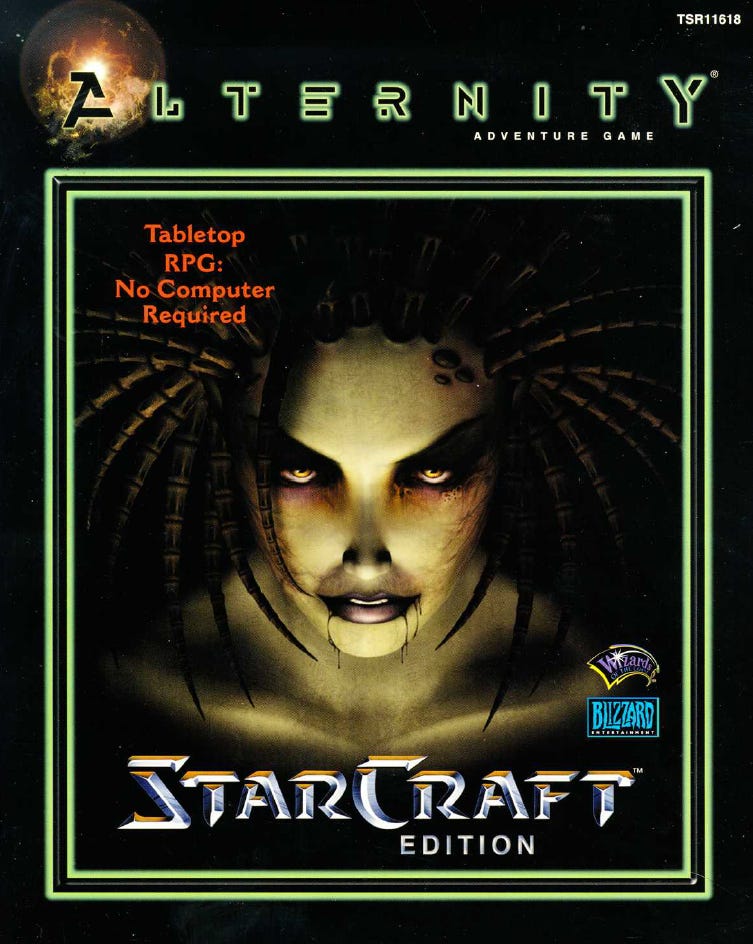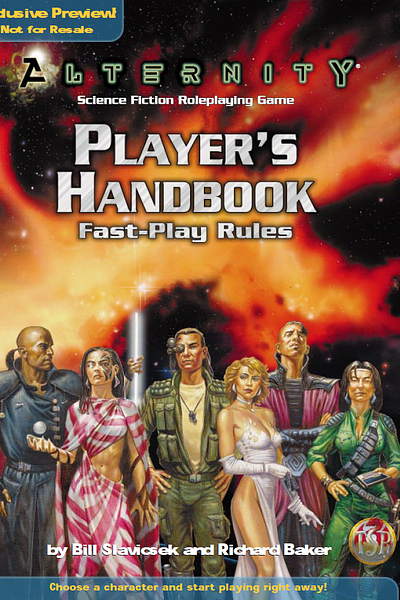A Starcraft Licensed RPG?
Strange Licensed Role Playing Games Selection #3
In the first two entries in my series on “Strange Licensed Role Playing Games,” I argued that there are many reasons why table top role playing game companies enter licensing agreements. One of these reasons is that it gives them the opportunity to expand their player base by reaching out to a new audience. In these cases, the licensed property is a kind of bait put out there in the hopes that the customers will be hooked when they see the interaction of the game rules and the property.
Another reason that companies license is to increase their existing market share by appealing to people who are already customers, but who might wander from the company from time to time because there is something lacking in the current product line. If the first kind of game is a bait and hook strategy, this second strategy is the soda wars strategy.
“Ah, you like the fresh taste of D&D, but FASA has Traveller with that sweet Science Fiction zing. How about you try Star Frontiers it’s great for the Science Fiction palette. Oh, you prefer it have a darker tone?…”
Examples of the bait and hook strategy included the the early licensed games like Heritage’s Star Trek and introductory role playing games like the Pokémon Jr. game. Examples of the soda wars strategy include the Amber Diceless Role Playing Game, which is the equivalent of an independent Jones Cola alternative, and this week’s game StarCraft Edition of the Alternity Roleplaying Game.
Ever since the release of Dungeons & Dragons in 1974, the company that publishes the first mass market role playing game tends to dominate the entire field. This has been true whether the company’s name was TSR, Wizards of the Coast, or Hasbro. From time to time Dungeons & Dragons becomes so dominant that it becomes synonymous with all roleplaying games.
What are you doing this weekend?
I’m playing D&D.
Cool, mind if I come over? I’ve got a cool Paladin I want to try out.
Oh, well we’re actually playing Runequest.
Excellent, I’ve got a Lunar Empire character.
Great! See you Saturday at 6pm?
Saturday?
Yeah.
Sorry, can’t make it. I’ve got plans Saturday night.
As much as the publishers of Dungeons & Dragons dominate the overall market, their dominance of genres outside of D&D Fantasy have been decidedly mixed. While they have published Western themed games like Boot Hill, Science Fiction games like Star Frontiers, Gangster era games like Gangbusters1, and even licensed games like Marvel Super Heroes (FASERIP and FATE), the smaller companies seem to hold the line and the market in these subcategories. Deadlands is a far more successful Western game, even if it’s Weird West, than Boot Hill. Traveller and Star Wars (d6 and Edge) are more successful Science Fiction games than Star Frontiers. No one really plays Gangster games and if they do Call of Cthulhu has the 1920s market cornered, and Justice Inc., Daredevils, Mercenaries, Spies, & Private Eyes, or GURPS Cliffhangers do as good if not a better job. Even Marvel was crushed by Champions in its heyday.
The Alternity role playing game2 was published in 1998 and was marketed as a role-playing game where players could play any science fiction story imaginable. Unlike TSR’s first science fiction role playing games – Metamorphosis Alpha, Gamma World and Star Frontiers – which each featured their own individual game mechanics, Alternity was meant to be a universal rules set that could be applied to multiple world settings.
Alternity was meant to be a kind of D&D for science fiction settings, and the release of AD&D style rule books (both a Player’s and Game Master’s guide were published) reinforced this presentation of the brand. The game featured an innovative “die step” mechanic where a player rolled a core 20-sided die (called the “control” die) and then rolled a supplementary “situation die” that ranged from a 4-sided to a 12-sided die. The value rolled on the situation die would be either added or subtracted from the roll on the 20-sided die, depending on the “situation,” and this would be compared to a character’s skill level. The goal is to roll as low a roll as possible.
I’m a big fan of die step systems and this one was very intuitive for those who had played D&D or other 20-sided die based systems. As I mentioned before, skill rolls and attacks were based on a character’s overall skill level and skill levels are based on a character’s ability scores. So a character with Dexterity of 11 might have a Ranged Attack Skill of 11 and need to roll an 11 or less to succeed at shooting an opponent if they hadn’t specialized in that particular skill by adding “ranks” to it. This skill roll is further divided into four categories A (Amazing), G (Good), O (Ordinary), and F (Failure) which describe how well a character succeeds at an action.
The rules were designed by veteran game designers Richard Baker and Bill Slavicsek and Bill had experience working on a number of licensed products including West End’s Star Wars game. Alternity was supported by a number of high quality sourcebooks that ranged from hard science fiction to low level superheroes. Among the best of the support material for the game was the X-Files-esque Dark*Matter campaign by Wolfgang Baur and Monte Cook. It was a remarkably well put together setting, but as was often the case a smaller company had already captured that niche.
If Dark*Matter was the highest point of the game system, then the Starcraft supplement/introductory product was the strangest. It isn’t strange that the role-playing game industry’s leading publisher would seek to publish a product based on one of the hottest science fiction games out there, no matter how much of a resemblance it bears to 40k. What is strange is that they would do so when it was clear that Alternity was going to be cancelled as a brand because the company’s new owners were prepping for the release of 3rd Edition D&D and eventually for d20 Modern and d20 Future. This sense is amplified by the fact that the other Blizzard licensed product from Wizards of the Coast, Diablo, was released using the 3rd Edition D&D rules set.
When one looks through the Alternity Starcraft set, one is struck by two things. First, that the product is clearly intended as an introductory product meant to lure in the computer gamer and to lure existing gamers away from other Science Fiction games, the box was designed to look like a video game box. Second, that not a lot of thought was put into answering the question “what’s next?” While this introductory set had a simplified version of the Alternity system, the company never released any expansive campaign material for StarCraft. I don’t know how many units of this game set Wizards produced and sold. I do think that they might have been better served releasing an Alternity: Star Frontiers product.
I’m including copies of the “Fast Play” rules for Alternity in this post because these were once free products on the Wizards of the Coast website meant to be distributed for free. If the game intrigues you, check out the link below for the new Sasquatch Game Studio version of the game.
Gangbusters is currently in kind of a limbo state. Mark Hunt published a B/X adaptation of the rules and owned/owns the Trademark, but he took down his B/X rules set even as he offers some expansion products.









